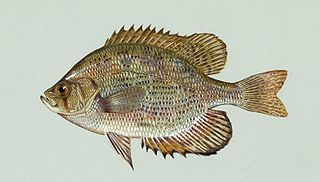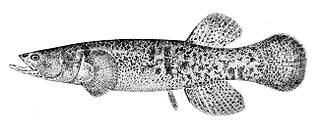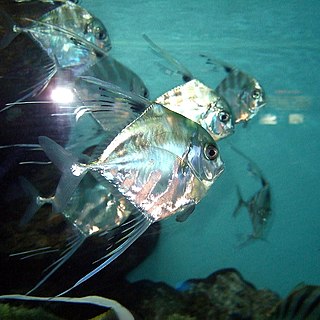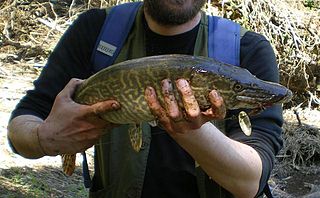The American pickerels are two subspecies of Esox americanus, a medium-sized species of North American freshwater predatory fish belonging to the pike family :

Centrarchidae, better known as sunfishes, is a family of freshwater ray-finned fish belonging to the order Perciformes, native only to North America. There are eight universally included genera within the centrarchid family: Lepomis, Micropterus, Pomoxis (crappies), Enneacanthus, Centrarchus, Archoplites, Ambloplites, and Acantharchus. A genetic study in 2012 suggests that the highly distinct pygmy sunfishes of the genus Elassoma are also centrarchids.

Salmonidae is a family of ray-finned fish that constitutes the only currently extant family in the order Salmoniformes, consisting of 11 extant genera and over 200 species collectively known as "salmonids" or "salmonoids". The family includes salmon, trout, char, graylings, freshwater whitefishes, taimens and lenoks, all coldwater mid-level predatory fish that inhabit the subarctic and cool temperate waters of the Northern Hemisphere. The Atlantic salmon, whose Latin name became that of its genus Salmo, is also the eponym of the family and order names.

The Esociformes is a small order of freshwater ray-finned fish, with two families, Umbridae and Esocidae. The pikes of genus Esox give the order its name.

The northern pike is a species of carnivorous fish of the genus Esox (pikes). They are commonly found in moderately salty and fresh waters of the Northern Hemisphere. They are known simply as a pike in Great Britain, Ireland, most of Eastern Europe, Canada and the U.S., although in the Midwest, they may be called a Northern.

The Amiiformes order of fish has only two extant species, the bowfins: Amia calva and Amia ocellicauda, the latter recognized as a separate species in 2022. These Amiiformes are found in the freshwater systems of North America, in the United States and parts of southern Canada. They live in freshwater streams, rivers, and swamps. The order first appeared in the Triassic, and the extinct members include both marine and freshwater species, many of which are morphologically disparate from bowfins, such as the caturids.
Hemiramphidae is a family of fishes that are commonly called halfbeaks, spipe fish or spipefish. They are a geographically widespread and numerically abundant family of epipelagic fish inhabiting warm waters around the world. The halfbeaks are named for their distinctive jaws, in which the lower jaws are significantly longer than the upper jaws. The similar viviparous halfbeaks have often been included in this family.

The Osmeriformes are an order of ray-finned fish that includes the true or freshwater smelts and allies, such as the galaxiids and noodlefishes; they are also collectively called osmeriforms. They belong to the teleost superorder Protacanthopterygii, which also includes pike and salmon, among others. The order's name means "smelt-shaped", from Osmerus + the standard fish order suffix "-formes". It ultimately derives from Ancient Greek osmé + Latin forma, the former in reference to the characteristic aroma of the flesh of Osmerus.

Esox is a genus of freshwater fish commonly known as pike or pickerel. It is the type genus of the family Esocidae. The type species of the genus is Esox lucius, the northern pike.

The chain pickerel is a species of freshwater fish in the pike family of order Esociformes. The chain pickerel and the American pickerel belong to the Esox genus of pike.

The Alaska blackfish is a species of freshwater fish in the esocid family (Esocidae) of order Esociformes. It inhabits Arctic regions of Alaska as well as Siberia and the Bering Sea islands.

The Olympic mudminnow is a fish native to the western lowlands of Washington: the Chehalis River basin, Deschutes River basin, and some Olympic Peninsula basins. It grows to 8 cm in length, and is Washington's only known endemic freshwater fish species. Although they strongly resemble killifish, mudminnows are more closely related to pike and muskellunge.

Novumbra is a genus of mudminnows native to Oregon and Washington state, USA. Molecular data suggests that this genus is more closely related to Esox than Dallia and Umbra. Novumbra diverged from Esox roughly 65 million years ago in the Paleocene.

Alectis is a genus of fish in the family Carangidae containing three extant species, all of which are large marine fishes. They are commonly known as threadfish, diamond trevallies or pompanos, although they have no close affiliation with the true pompano genus.

Umbridae is a family of fish in the order Esociformes, which contains pike, pickerel, and mudminnows. The single living genus, Umbra, occupies weed-choked freshwater habitats in eastern North America and eastern Europe. While the family traditionally contained the genera Umbra, Novumbra, and Dallia, recent genetic and paleontological research have recovered this grouping as paraphyletic, with Novumbra and Dallia being moved to the family Esocidae.

Gnathorhiza is an extinct genus of prehistoric lobe-finned fish (lungfish) which lived from the Carboniferous period to the Early Triassic epoch. It is the only known lungfish genus to have crossed the Permo-Triassic boundary. Several species have been described, ranging in size from 5 to 50 centimeters.

Esox cisalpinus, the southern pike or cisalpine pike, is a species of freshwater fish known from central and northern Italy, southeastern France and Switzerland, and it might also occur in the western Balkans. It has traditionally been considered a southern European variant of the widespread northern pike, but was described as a separate species in 2011. Like the northern pike, southern pike are an important species for recreational fisheries and for its role as a top predator in freshwater ecosystems.

Dallia is a genus of mudminnows native to Russia and Alaska. Molecular data indicates the genus is more closely related to Esox and Novumbra than Umbra.Dallia diverged from Novumbra + Esox approximately 66 million years ago.

The redfin pickerel is a subspecies of freshwater fish belonging to the pike family (Esocidae) of the order Esociformes. Not to be confused with its close relatives, the grass pickerel and the chain pickerel, this fish is unique in the fact that it has brightly colored red fins. Like all pikes, the redfin pickerel is an ambush predator, lying amongst thick vegetation in wait for smaller, more agile prey to enter within its range of attack.

Stomiati is a group of teleost fish belonging to the cohort (group) Euteleostei, which is a group of bony fishes within the infra-class Teleostei that evolved ~240 million years ago. Teleostei is a group of ray-finned fishes with the exception of primitive bichirs, sturgeons, paddlefishes, freshwater garfishes, and bowfins. The cohort of Euteleostei is divided into two smaller groups: the Protacanthopterygii and the Neoteleostei. Stomiati happen to be descendants of the Protacanthopterygii, and contains the order of Osmeriformes and Stomiiformes.















